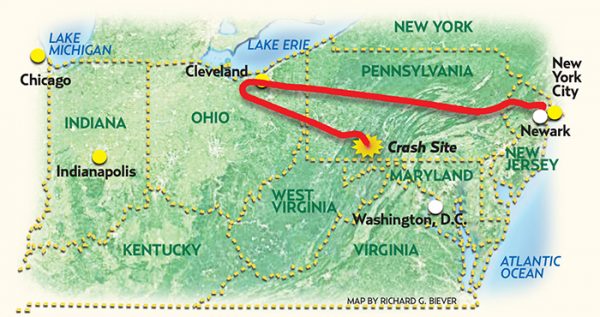
TRACKING UNITED FLIGHT 93: United Flight 93 was delayed, but took off from Newark International Airport at 8:42 a.m., Sept. 11, 2001, just minutes before the first hijacked plane hit the North Tower of the World Trade Center in New York. It was to have been a non-stop flight to San Francisco. Aboard were 33 passengers, seven crew members and four Islamic terrorists. The flight was nearing the Ohio state line, beginning to be tracked by air traffic controllers in Indianapolis, when it was taken over by the terrorists around 9:30 a.m. It made a U-turn near Cleveland and headed southeast toward Washington, D.C. Passengers are credited with trying to overtake the terrorists who crashed the plane near Shanksville, Pennsylvania, at 10:03, 20 minutes away from Washington.
Like most Americans on the morning of Sept. 11, 2001, staff members at Somerset Rural Electric Cooperative in Pennsylvania were following the horrific morning events unfold on televisions in the office. Two hijacked commercial jet liners, loaded with fuel, smashed into the twin towers of the World Trade Center in New York City, and a third went into the Pentagon near Washington, D.C. A fourth jet still in the air was unaccounted for.
Then, the daily routine of utility work interrupted. “We got a call about an outage near Indian Lake around 10:15 a.m., so we contacted a crew we already had in the field,” recalled Richard Bauer, who was general manager of the co-op at the time.
Based in Somerset, the co-op serves about 13,000 consumers in four southwestern Pennsylvania counties as well as one over the state line in Maryland. Indian Lake was near Shanksville in the eastern part of the REC’s territory.
Just seconds into dispatching the line crew, everything changed. “For the first time ever, 911 interrupted our transmission and told us an airliner was down and may be related to our outage,” Bauer said.
Co-op personnel arrived at the site even before police and fire personnel, but little was visible on the surface of the reclaimed strip mine. “From where we stood about 150 to 200 yards away, there was a crater-like hole that you couldn’t tell how big it was,” Bauer said. “Once you walked up to it, you saw paper, pieces of fiberglass, but there wasn’t enough debris on the ground to convince me a large plane had crashed.”
The Boeing 757 had burrowed in upon impact, and some of the broken debris was more than 40 feet below ground. “The plane went into the ground like a hand going into a bowl of sand,” said Bauer.
Co-op personnel were tasked with providing power for the massive recovery effort that took place over the next several weeks as part of the United Airlines Flight 93 investigation. “The one thing everybody needed was power,” Bauer said. “We had to work around the constraints of a huge crime scene, and even had to access and modify an investor-owned utility’s abandoned line nearby to get the necessary power to the site.”
In the short term, the co-op installed scores of meters and breaker boxes to electrify a growing city of trailers and RVs hauled in to support the investigation.
As time passed, a makeshift memorial, honoring the passengers aboard Flight 93 grew at the site. The passengers, who stormed the cockpit, are credited with causing the plane to crash there, instead of letting the terrorists pilot it into the U.S. Capitol or White House 20 minutes away.
On the fifth anniversary of the attacks, the co-op received word that President George W. Bush would visit the crash site to take part in commemorative activities the next day. The REC was asked to supply the power. Co-op crews worked into the evening to provide special hookups that would not be visible, as requested, in the barren field.
The site is now a national memorial, served electrically by the REC. It is regularly the first stop on the Indiana Electric Cooperative Youth Tour to Washington, D.C., for high school seniors as its motor coaches head east to the nation’s capital.
This article was edited from stories appearing in Penn Lines, the publication of Pennsylvania’s electric cooperatives, Electric Co-op Today, a news publication of the National Rural Electric Cooperative Association, and other accounts from other electric cooperative publications.



